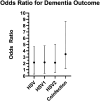Increased risk of dementia associated with herpes simplex virus infections: Evidence from a retrospective cohort study using U.S. electronic health records
- PMID: 39956964
- PMCID: PMC12231789
- DOI: 10.1177/13872877251317228
Increased risk of dementia associated with herpes simplex virus infections: Evidence from a retrospective cohort study using U.S. electronic health records
Abstract
Background: Alzheimer's disease is the most common age-related dementia. Recent compelling evidence from previous retrospective electronic health record (EHRs) studies suggests that herpes simplex virus (HSV) infections may be a risk factor for developing dementia. However, no age and propensity score matched studies have been published in a United States general population cohort study to date.
Objective: We aimed to identify whether HSV infection shows a significantly increased risk of the development of dementia in a sizable and heterogeneous cohort. We investigated whether herpes simplex virus type 1 (HSV1), herpes simplex virus type 2 (HSV2), or coinfections with both serotypes pose a greater risk of developing dementia across different biological sexes and racial groups.
Methods: EHRs from patients with a history of HSV or specific serotypes (HSV1 or HSV2) infection were selected for analysis. These records were compared to a propensity-matched control group and analyzed for hazard and odds ratios through TriNetX.
Results: There was a significant difference in dementia incidence in the HSV-infected group versus the control. Individuals with a history of HSV, HSV1, HSV2, and coinfection all showed a significant risk of developing dementia compared to controls. Males with HSV2 are at a higher risk of dementia outcome than females with HSV2.
Conclusions: While consistent with previous reports, these findings are the first to establish a higher risk of developing dementia in patients who have any HSV diagnosis using a nationwide, population-based matched cohort study in the United States.
Keywords: Alzheimer's disease; clinical outcomes; dementia; electronic health records; herpes simplex virus.
Conflict of interest statement
Declaration of conflicting interestsGiulio Taglialatela, PhD, is an Editorial Board Member of this journal but was not involved in the peer-review process of this article, nor had access to any information regarding its peer-review.The remaining authors declared no potential conflicts of interest with respect to the research, authorship, and/or publication of this article.
Figures




References
-
- Wang Y, Tang Y, Liu T-H, et al. Integrative multi-omics analysis to characterize herpes virus infection increases the risk of Alzheimer’s disease. Mol Neurobiol 2024; 61: 5337–5352. - PubMed
-
- Masters CL, Bateman R, Blennow K, et al. Alzheimer’s disease. Nat Rev Dis Primer 2015; 1: 15056. - PubMed
-
- Alzheimer’s Disease: Essential Facts and Statistics Everyone Should Know. The Fisher Center for Alzheimer’s Research Foundation, https://www.alzinfo.org/understand-alzheimers/alzheimers-disease-facts-a... (accessed 13 June 2024).
MeSH terms
Grants and funding
LinkOut - more resources
Full Text Sources
Medical

